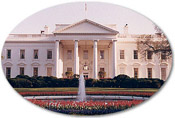


White House Facts
There are 132 rooms, 32 bathrooms, and 6 levels to accommodate all the people who live in, work in, and visit the White House. There are also 412 doors, 147 windows, 28 fireplaces, 7 staircases, and 3 elevators.
At various times in history, the White House has been known as the “President's Palace,” the “President's House,” and the “Executive Mansion.” President Theodore Roosevelt officially gave the White House its current name in 1901.
The White House receives approximately 6,000 visitors a day. With five full-time chefs, the White House kitchen is able to serve dinner to as many as 140 guests and hors d'oeuvres to more than 1,000.
The White House requires 570 gallons of paint to cover its outside surface.
For recreation, the White House has a variety of facilities available to its residents, including a tennis court, a jogging track, swimming pool, movie theater, billiard room, and a bowling lane.
The White House as Symbol and Home
Millard Fillmore
(1850-1853)
had the first kitchen stove installed in the White House; his wife Abigail
established the White House library.
Rutherford B. Hayes
(1877-1881)
had the first phone installed in the White House, in 1879.
Chester A. Arthur
(1881-1885)
had the first elevator installed in the White House in 1882.
Benjamin Harrison
(1889-1893)
had the first electric lights installed in the White House, in 1891.
William H. Taft
(1909-1913)
had the first cars at the White House, starting in 1909.
Dwight D. Eisenhower
(1953-1961)
had the first putting green installed on the White House lawn, in 1953.







